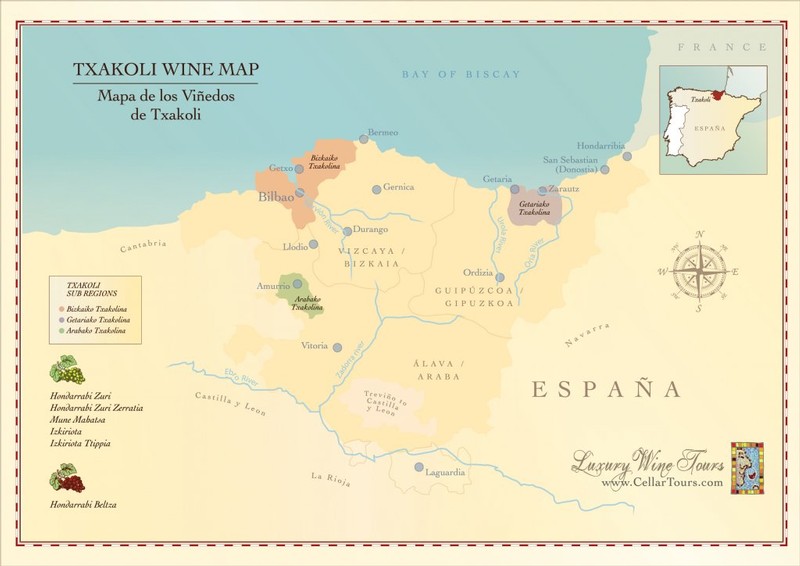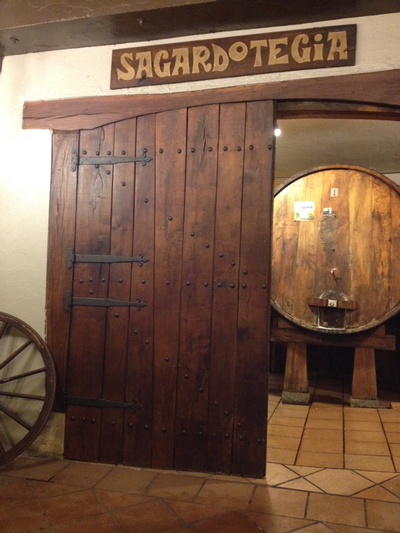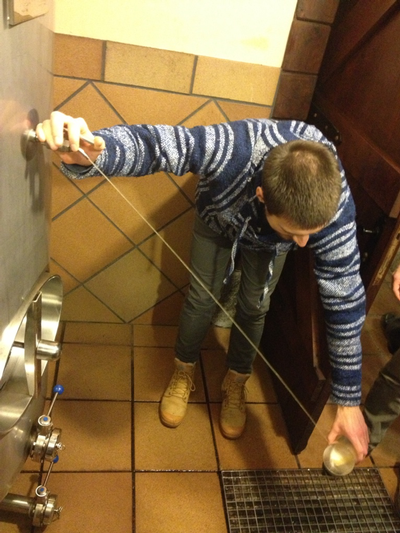Peeking into Basque Country: Cider, Txakoli and a Meal
Peeking into Basque Country: Cider, Txakoli and a Meal

You walk into a building of stone and heavy, old timber, and are greeted by the smell of grilled beef fat, sheep’s milk, and apples. These are not perfect grocery store Honeycrisps. These apples are tart, bitter, and hard. These are apples with a past. You find an open spot at a table, probably standing, and as you settle in, you notice your neighbors. Everyone seems to be eating, drinking, and speaking all at once, and the low, hard ceilings bathe you in a language that has no western analogues. Your ears quickly decide that there are far too many x’s and z’s.
A server delivers a plate of chorizo and an empty glass. Someone shouts, “Txotx!” (which sounds to you like “Choach!”), and a queue of empty cider glasses with people attached to them forms in front of a giant barrel that you somehow missed when you came in. You join the line, and when you reach the front, a kind stranger taps the barrel, spraying a thin stream of cloudy, frothing cider into your glass. As you return to your table, you sniff. A little sour, a little funk, maybe a touch of cider vinegar. An omelet flecked with pungent salt cod has joined your chorizo. You fork yourself a bite of omelet and wash it down with a swallow of cider. The richness of the egg and the saltiness of the cod shake hands with the tannic brightness of the cider, becoming business partners in your mouth. Your server delivers a steaming heap of rare, bone-in beef to your neighbors, and tells you to finish your omelet, your steak is on its way. The call of “Txotx!” comes again, and you realize that your glass has mysteriously emptied itself. The meal has just begun.

Photo courtesy of Chandler Briggs
Basque cider houses, or sagardotegi, have become an improbable tourist attraction in northeastern Spanish towns like Astigarraga and Hernani. Basque Country has a long history of cider production. Its fisherman and whalers were renowned in the 16th and 17th century, ranging far afield in ships fitted with internal cider casks. The crew members would drink up to three liters per day, staving off scurvy with the tart cider.
Basque cider, unlike other European ciders from England or Normandy, is generally still, though some show a light effervescence like Txakoli. They are dry, with little to no residual sugar, and can be quite tannic, like red wine or heavily steeped tea. They are the wild ales of the cider realm, unapologetically unfiltered and funky. The traditional Basque high pour (again, also used on Txakoli) acts like a splash decant for wine, blowing off some of the funk to reveal the fruit within. Basque ciders are delicious by themselves as an aperitif, but they really shine on the dinner table. Everyone has plenty of time to cook these days, so let’s make a Basque cider house dinner!

Photo Courtesy of Chandler Briggs
The traditional, protein-heavy sagardotegi menu begins with a plate of hard, spicy chorizo, followed by the salt cod omelet. Salt cod, or bacalao, is common throughout Portugal and Spain, and can be purchased online. It is a great pantry item, as the salt cure keeps it fresh for years. Remember to soak your salt cod for a day before preparing it, rinsing it several times in fresh water.
The second course is roasted white fish with grilled peppers. I prefer halibut, but you could also use (fresh, uncured) cod. Any small, green pepper will do, though I like shishito peppers for their sweet flavor and thin, quickly grilled skin.
The fourth and main course is the Txuleta steak, a bone-in rib steak grilled over coals. The steaks are sourced from cattle that are much older than the beef that Americans eat, usually 8-18 years old (most American cattle are slaughtered before 30 months). You can stick with a rib-eye for authenticity or branch out with an alternative cut. Erick Turner, owner of Butcher Butcher Walla Walla, recommends sirloin cap or hanger.
The final course is a cheese plate. Most Basque cheeses are made from sheep’s milk, reflecting their strong shepherding culture. The clean brightness of aged sheep cheeses like Abbaye de Belloc, Idiazabal, or Petit Basque helps to tame the wildness of the ciders. Manchego, Pecorino, or local Monteillet Fromagerie make fine, locally available substitutes. Traditional accompaniments include walnuts and quince paste, though sliced apple or pear will serve.
This menu is a little meat-heavy, so feel free to serve some veggie pinxtos (Basque tapas) to round out the meal. Asparagus is in season here in Walla Walla and in Basque country, so grill up some spears next to your peppers and steak. Spring onions will be coming on strong too. Serve them halved or quartered and grilled, ideally with a swipe of Catalan romesco (jarred peppers, tomato paste, nuts, stale bread, and vinegar makes this the ultimate quarantine friendly pantry sauce). Finally, no tapas menu would be complete without fried patatas bravas and lemony, garlicky aioli. Double fry the potatoes and use an immersion blender to take the broken-emulsion fuss out of the aioli. Txotx!
“We ate at long trestle-tables out of permanently greasy tin pannikins, and drank out of a dreadful thing called a porron. A porron is a sort of glass bottle with a pointed spout from which a thin jet of wine spurts out whenever you tip it up; you can thus drink from a distance, without touching it with your lips, and it can be passed from hand to hand. I went on strike and demanded a drinking-cup as soon as I saw a porron in use.” George Orwell, genius and apparent fuddy-duddy, in “Homage to Catalonia”
About the Porron
If a porron looks like a cross between a watering can and a decanter, that’s because it is! The porron is a hand-held glass pitcher that pours a thin stream of wine, ideally from a great height. You can drink anything out of a porron, but traditionally they are used for Txakoli, cider, or Cava. The porron is probably descended from conical Roman drinking cones named rhyton, and the Catalonians have perfected its use. To drink from a porron, place the spout close to your mouth and tip the pitcher. Catch the stream in your mouth, then slowly pull the container further away from your body, until it is at arm's length. The further the distance between the porron and your mouth, the more points you get. A porron is a crazy straw for grown-up drinks, and it makes your drinks taste better too. This stylish variation on the Basque high pour aerates your wine or cider, opening up the beverage just like a decanter. Grab your new porron and a bottle of Txakoli - or three - and pour on!

Photo courtesy of De Maison Selections
Let us not forget Txakoli!
Basque country straddles the Pyrenees on the border between France and Spain. Likewise, its most famous wine straddles the border between sparkling and still. Txakoli is a frisky, lightly effervescent wine, similar in style to an Italian frizzante. Originally, the wines were fermented in large wooden foudre, like the aforementioned ciders, though nowadays you are more likely to find stainless steel tanks. Stainless is a valuable tool because it allows the winemaker to control the temperature of the vessel. When fermentation has completed, the tanks are cooled to just above freezing, capturing and preserving the carbon dioxide that the yeasts have produced.
This kiss of CO2, when combined with low alcohol1 and whiplash acidity, make Txakoli one of the most energetically gulpable wines out there. These are the session beers of the wine world, wines that you can drink for hours without feeling weighed down or groggy. Before dinner, entertain yourself by learning the Basque high pour!
During dinner, Txakoli pairs well with darn near everything. These wines are literally zesty, exhibiting a touch of citrus pith that fans of Albariño or Pinot Grigio will be familiar with. This phenolic bitterness allows for pairings with classically difficult vegetable courses like baby peas or spicy salad greens. Follow the vegetables with clams in a parsley sauce, or crispy pork belly, or a fava bean and spring onion stew. Finally, finish your meal in true Basque-style with your cheese plate from earlier. You did remember to make your cheese plate, didn’t you?
[1] Single digit abv’s are not rare